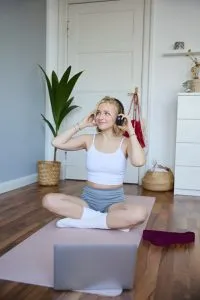Imagine you’re in warrior pose, holding the position for what feels like an eternity. Your legs are shaking, your mind is racing about tomorrow’s meeting, and you’re mentally grocery shopping while trying to “find your zen.” Sound familiar?
If you’ve ever found yourself physically present on your yoga mat but mentally writing your to-do list during savasana, you’re not alone. This disconnect between body and mind is exactly why mindfulness meditation has become the secret sauce that transforms a good yoga practice into a life-changing one.
The beautiful truth is that yoga and mindfulness meditation aren’t just complementary practices—they’re like old friends who’ve been waiting to reunite. When you blend the physical movement of yoga with the mental awareness of mindfulness meditation, something magical happens. Your practice becomes deeper, your stress melts away more effectively, and those elusive moments of peace become much more accessible.
The Ancient Connection – Why Yoga and Mindfulness Meditation Are Perfect Partners
Let’s take a quick trip back in time. Both yoga and mindfulness meditation share ancient roots that stretch back thousands of years. In traditional yoga philosophy, the physical postures (asanas) were actually designed to prepare the body for meditation. Think of it as getting comfortable in your favorite chair before settling in for a good book.
The word “yoga” itself means “union”—the connection between mind, body, and spirit. Mindfulness meditation is simply the practice of being fully present and aware of what’s happening in the moment, without judgment. When you combine these two practices, you’re essentially doubling down on presence and awareness.
I remember my first yoga class vividly. I spent most of it watching other people, comparing my wobbly tree pose to their seemingly effortless balance. It wasn’t until I discovered mindfulness that I learned to turn my attention inward, to actually feel what my body was doing rather than worrying about how it looked.
Understanding Mindfulness Meditation in the Context of Yoga
So what exactly is mindfulness meditation, and how does it fit into your yoga routine? Simply put, mindfulness meditation is the practice of paying attention to the present moment with curiosity and kindness—no judgment allowed.
Mindfulness meditation teaches you to become the observer of your thoughts rather than getting swept away by them. It’s like sitting by a river and watching the water flow by, rather than jumping in and getting carried downstream. This skill becomes incredibly valuable when you’re holding a challenging pose and your mind starts its usual chatter: “This hurts,” “I can’t do this,” “When will this be over?”
The beauty of integrating mindfulness into yoga is that it transforms your practice from a physical workout into a moving meditation. Instead of just going through the motions, you begin to:
- Notice the subtle sensations in your body
- Observe your breath patterns without trying to control them
- Acknowledge thoughts and emotions as they arise
- Accept whatever you’re experiencing without resistance
Research from the Mayo Clinic shows that mindfulness meditation can help reduce stress, anxiety, pain, and even improve sleep quality—benefits that perfectly complement what we’re already seeking from our yoga practice.
The Science-Backed Benefits of Mindfulness in Yoga
Here’s where things get really exciting. When you combine yoga with mindfulness meditation, the benefits aren’t just additive—they’re multiplicative. Studies have shown some pretty remarkable results:
Stress Reduction That Actually Sticks
We all know yoga helps with stress, but adding mindfulness meditation takes it to the next level. The practice of Mindfulness-Based Stress Reduction (MBSR) has been extensively studied and shown to reduce stress hormones like cortisol while increasing feel-good neurotransmitters.
When you’re mindfully moving through your yoga sequence, you’re essentially giving your nervous system a double dose of calm. Your body gets the physical release of tension, while your mind learns to step back from stressful thoughts.
Enhanced Body Awareness
One of the most immediate benefits of mindfulness in yoga is heightened body awareness. Instead of muscling through poses, you start to notice subtle cues from your body. That tight hip suddenly has a voice, and that shoulder tension becomes impossible to ignore.
This increased awareness helps prevent injuries and makes your practice more effective. You learn to work with your body rather than against it, finding the sweet spot between effort and ease that yoga teachers are always talking about.
Improved Focus and Mental Clarity
Ever notice how scattered your thoughts can be during a busy day? Mindfulness meditation acts like a mental reset button. When practiced alongside yoga, it helps sharpen your focus both on and off the mat.
Research from Verywell Mind indicates that regular mindfulness practice can improve attention span and reduce mind-wandering. In practical terms, this means you’re more present during your yoga practice and carry that focused awareness into your daily life.
Practical Meditation Techniques for Yoga Practitioners
Now let’s get to the good stuff—how do you actually integrate mindfulness meditation into your yoga practice? Here are some meditation techniques for yoga practitioners that are simple to learn but profound in their impact:
Breath Awareness During Asanas
Your breath is like a bridge between your body and mind, and it’s always available as an anchor for mindfulness. Try this – In your next yoga session, make your breath the star of the show rather than the poses themselves.
- Inhale and notice how your body naturally expands
- Exhale and feel your body gently contracting
- Pause between breaths and notice the stillness
When your mind wanders (and it will), simply return your attention to the breath. No judgment, no frustration—just a gentle return to the present moment.
Body Scan Integration
The body scan is a classic mindfulness technique that works beautifully with yoga. As you move through your practice, take moments to mentally scan your body from head to toe. Notice areas of tension, relaxation, warmth, or coolness without trying to change anything.
This technique is particularly powerful during longer holds in poses like warrior II or goddess squat. Instead of counting the seconds until you can release, use the time to explore the sensations arising in your body.
Mindful Transitions
Often, we rush between poses as if we’re checking items off a to-do list. But the transitions between poses are goldmines for mindfulness practice. Try moving slowly and deliberately, noticing how your weight shifts, how your muscles engage and release.
Think of it like this – if the poses are the destinations, the transitions are the journey—and we all know the journey is often more interesting than the destination.
How Mindfulness Enhances Your Yoga Practice
Let me share a story that perfectly illustrates how mindfulness enhances yoga practice. I used to approach yoga like a fitness class—go hard, push through discomfort, and measure success by how many difficult poses I could master.
Then I discovered mindfulness meditation, and everything changed. Instead of forcing my body into poses, I began to listen to what it was telling me. Some days, my hamstrings were tight and needed gentle coaxing. Other days, my hips were open and ready for deeper stretches.
This shift from doing yoga to being present during yoga transformed not just my practice, but my relationship with my body and myself. Here’s how mindfulness can enhance your practice too:
Deeper Connection to Your Body’s Wisdom
Your body is incredibly intelligent—it knows what it needs if you’re willing to listen. Mindfulness helps you tune into these subtle signals. Maybe today your back needs gentle twists rather than deep backbends, or perhaps your nervous system is calling for restorative poses rather than vigorous flow.
Reduced Risk of Injury
When you’re present and aware, you’re much less likely to push beyond your body’s limits. Mindfulness teaches you to distinguish between beneficial sensation (the good kind of stretch) and potentially harmful pain (the “stop now” signal).
Increased Emotional Regulation
Yoga has a sneaky way of bringing up emotions—sometimes ones we didn’t even know were there. Hip openers, anyone? Mindfulness meditation gives you tools to meet these emotions with curiosity rather than resistance, allowing them to move through you naturally.
Enhanced Spiritual Connection
For many practitioners, yoga is about more than physical fitness—it’s a spiritual practice. Mindfulness meditation can deepen this connection by helping you access states of presence and awareness that feel transcendent.
Creating Your Mindful Yoga Routine
Ready to start integrating mindfulness meditation into your yoga practice? Here’s a simple framework to get you started:
Before You Begin (5 minutes)
- Sit quietly and take a few conscious breaths
- Set an intention for your practice (not a goal, but a quality you’d like to cultivate)
- Check in with your body and notice how you’re feeling
During Your Practice
- Stay present with each movement and breath
- Notice when your mind wanders and gently redirect attention
- Pause between poses to maintain awareness
- Listen to your body’s signals and honor them
After Your Practice (5 minutes)
- Rest in savasana for at least 5 minutes
- Practice gratitude for what your body accomplished
- Notice any shifts in how you feel compared to when you started
Common Challenges and How to Overcome Them
Let’s be honest—integrating mindfulness meditation into your yoga practice isn’t always easy. Here are some common challenges and practical solutions –
“My Mind is Too Busy”
This is probably the number one complaint I hear from students. Here’s the thing – a busy mind isn’t a problem to solve—it’s simply what minds do. The practice isn’t about stopping thoughts but changing your relationship with them.
Solution: Start small. Even 30 seconds of mindful breathing is valuable. Remember, every time you notice your mind has wandered and bring it back, you’re actually succeeding at mindfulness.
“I Feel Uncomfortable with Emotions”
Yoga and mindfulness can bring up emotions we’ve been avoiding. This is actually a good thing, but it can feel overwhelming at first.
Solution: Remember that emotions are temporary visitors, not permanent residents. Practice the RAIN technique – Recognize what you’re feeling, Allow it to be there, Investigate with kindness, and Non-attachment—let it pass naturally.
“I Don’t Have Time”
This one makes me chuckle because mindfulness doesn’t require extra time—it transforms the time you already spend practicing yoga.
Solution: You don’t need to add hours to your routine. Simply bringing awareness to your existing practice is enough to start experiencing benefits.
Advanced Practices for Dedicated Students
Once you’ve established a foundation, you might want to explore deeper practices:
Walking Meditation Integration
Try beginning or ending your practice with a few minutes of walking meditation. Walk slowly, feeling your feet connect with the ground, noticing the subtle movements required for balance.
Loving-Kindness During Restorative Poses
During longer restorative holds, practice sending loving-kindness to yourself and others. This can be particularly powerful during heart-opening poses.
Mindful Partner Yoga
If you practice with others, try incorporating moments of shared mindfulness—breathing together, moving in synchronized rhythm, or simply holding space for each other’s practice.
Frequently Asked Questions
What’s the difference between mindfulness and meditation in yoga?
Mindfulness is a quality of awareness—being present and non-judgmental about what’s happening right now. Meditation is a formal practice that cultivates mindfulness. In yoga, you can practice mindfulness throughout your entire session (staying present with breath and body), while meditation might be a specific seated practice before or after your physical practice.
How long should I meditate before or after yoga?
Start small and build gradually. Even 3-5 minutes of mindfulness meditation before yoga can set a powerful intention for your practice. After yoga, try staying in savasana for at least 5-10 minutes to integrate the benefits. The key is consistency rather than duration—it’s better to meditate for 5 minutes daily than 30 minutes once a week.
Can mindfulness meditation replace my regular yoga practice?
While mindfulness meditation offers incredible benefits, it complements rather than replaces physical yoga practice. The combination of movement, breath, and mindfulness creates a synergistic effect that’s more powerful than either practice alone. Think of them as dance partners—each beautiful on their own, but magical together.
I keep getting distracted during mindful yoga. Am I doing it wrong?
Getting distracted is not a failure—it’s actually part of the practice! The magic happens when you notice you’ve been distracted and gently return your attention to the present moment. This “noticing and returning” is the exercise that strengthens your mindfulness muscle. Be patient and kind with yourself.
What if I feel emotional during mindful yoga practice?
Feeling emotional during yoga and mindfulness practice is completely normal and actually a sign that the practices are working. Yoga and mindfulness can help release stored tension and emotions. Allow yourself to feel whatever comes up without judgment, breathe through it, and remember that emotions are temporary. If feelings become overwhelming, consider working with a qualified instructor or therapist.
Your Journey Starts Now
Integrating mindfulness meditation into your yoga practice isn’t about perfection—it’s about showing up with curiosity and kindness for whatever arises. Some days you’ll feel like a zen master floating through your flow. Other days, you’ll spend most of your practice gently redirecting your wandering mind back to your breath. Both are perfect.
The beautiful thing about this journey is that every moment offers a fresh opportunity to begin again. Whether you’re a beginner unrolling your mat for the first time or a seasoned practitioner looking to deepen your experience, mindfulness meditation can transform your yoga practice from the inside out.
Start small, be patient with yourself, and trust the process. Your body, mind, and spirit will thank you for it. After all, the goal isn’t to achieve some perfect state of zen—it’s to show up fully for the messy, beautiful, imperfect experience of being human.
Ready to transform your practice? Try incorporating just one mindful breath at the beginning of your next yoga session. Notice what happens when you truly arrive on your mat—not just physically, but mentally and emotionally too. That’s where the real magic begins.

















